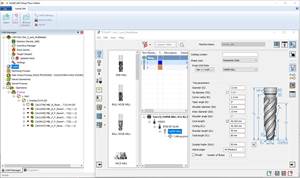Translation Software Translates Into Savings
This precision machine shop faced the prospect of purchasing a $30,000 CATIA workstation to make translations of CATIA models for their CNC programming system, or lose business.
Share





Aero CNC, a precision machine shop in the Fort Worth, Texas suburb of Burleson faced the prospect of purchasing a $30,000 CATIA workstation to make translations of CATIA models for their CNC programming system. Their main customer, Lockheed Martin Aeronautics in nearby Fort Worth, had issued a supplier alert indicating they would no longer be making Initial Graphic Exchange Specification (IGES) translations of their CATIA models. They would provide models only in the CATIA native format. It would be up to the supplier either to work directly with the CATIA files or make translations on their own.
CATIA's IGES translators did not always provide the clarity needed by the suppliers. Entities were sometimes missing in the translated file. Lines were absent and some surfaces did not have all their nodes. When they discovered that data was missing, they instructed the CNC program to provide a best fit by interpolating over the missing data. However, they were often uncomfortable with this approximation and would have to request the missing data from the customer. They felt they had to depend upon the clarity of the model, because they often operate in a "green release" environment, working on designs that are so new that physical prototypes are not available for reference.
The aerospace components that they machine for Lockheed range from bulk heads and ribs to longerons (fuselage framing members) and canopy latches. They have worked on more than 220 different parts from Lockheed. The shop performs complex, multi-axis surfacing on the components, for example, when generating swarf contours, which are formed by attaching a series of lines from any number of cross sections and any number of planes. They also perform five-axis contouring, revolved and swept tool paths, Coon's patch tool paths and others. The shop holds tolerances of at least ±0.005 inch and often work with tolerances of ±0.0002 inch. The shop also machines difficult materials—Inconel, titanium, 13-A aluminum and others.
While searching for a cost-effective means of making CATIA translations, they heard about an application-independent CATIA/IGES translation software that did not require a CATIA license. Additionally, the software ran under Microsoft Windows 95, the platform in use at the shop, and Windows NT, a platform they were planning on using later. The software, IGES/CAT (from Compunix, Inc., Southfield, Michigan) translates CATIA v.4.0 data files (export and model files) into IGES 5.1 compatible files.
They took Compunix up on the company's trial offer, which gave them a full working system to use for 30 days. After they downloaded the translator from the Compunix website, it only took them two days to become proficient with it.
As the software performs translations from CATIA to IGES, it substituted, or "mapped," the best alternative IGES entities for the CATIA entities that differed from the IGES standard.
Aero CNC reports that the software has increased their profitability, giving themtwo major sources of savings. First, they did not have to purchase a $30,000 CATIA seat. Second, they have cut about 30 percent of the time it took to translate files, since they did not have to extensively check the models or perform any re-work on them. In terms of time savings alone, the software paid for itself in a month. Aero CNC's customers have been impressed with their speed and quality of finished product and when the time comes to approach other CATIA-based businesses, they will have a selling point of using their CATIA files without their having to become involved in translations.
Related Content
Bringing Machining In-House to Keep up With Demand for Offroading Parts
To meet demand increases for its Ford offroad industry components, supplier RPG Offroad brought its machining processes in-house, saving the company nearly $50,000 per month. Here’s how its choice of integrated CAD/CAM software made it happen.
Read MoreOrthopedic Event Discusses Manufacturing Strategies
At the seminar, representatives from multiple companies discussed strategies for making orthopedic devices accurately and efficiently.
Read MoreThe Power of Practical Demonstrations and Projects
Practical work has served Bridgerland Technical College both in preparing its current students for manufacturing jobs and in appealing to new generations of potential machinists.
Read MoreBuilding A Powerful Bridge from the CAM Programmer to the Shop Floor Operator
SolidCAM for Operators provides a powerful bridge from CAM programming to the shop floor to best streamline the machine shop process with its CAM part simulation. It provides a clear picture to the operator for setup and prove-out, enables minor G-Code changes and avoids crashes, broken tools and scrapped parts.
Read MoreRead Next
Machine Shop MBA
Making Chips and Modern Machine Shop are teaming up for a new podcast series called Machine Shop MBA—designed to help manufacturers measure their success against the industry’s best. Through the lens of the Top Shops benchmarking program, the series explores the KPIs that set high-performing shops apart, from machine utilization and first-pass yield to employee engagement and revenue per employee.
Read MoreAMRs Are Moving Into Manufacturing: 4 Considerations for Implementation
AMRs can provide a flexible, easy-to-use automation platform so long as manufacturers choose a suitable task and prepare their facilities.
Read More




















